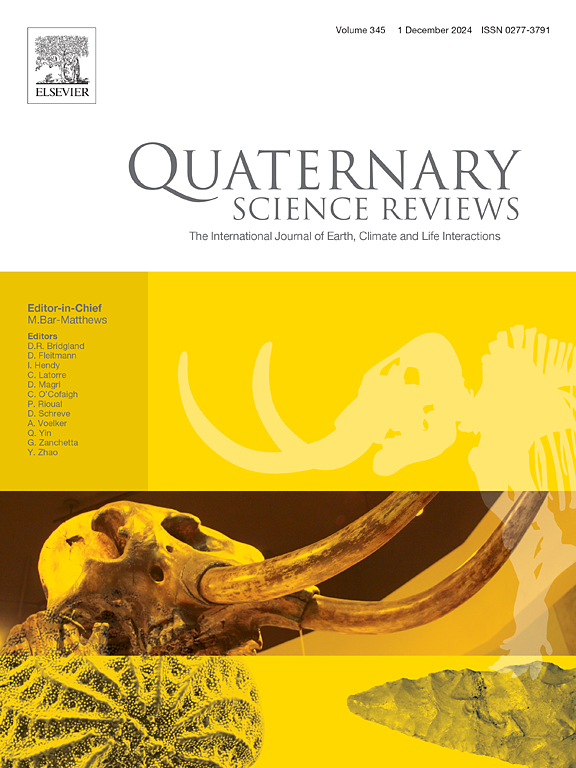Chironomid-inferred summer temperature during the Last Glacial Maximum in the Southern Black Forest, Central Europe
IF 3.2
1区 地球科学
Q1 GEOGRAPHY, PHYSICAL
引用次数: 0
Abstract
The location of Bergsee (382 m a.s.l.), between the Black Forest and northern Alpine glaciers during their maximum extent of the Würm glaciation, makes the sediment record of this lake a unique palaeoenvironmental archive that probably recorded the entire Last Glacial Period. Here we present a chironomid record from Bergsee covering ca. 35 thousands of years (kyr) including the period corresponding to the Last Glacial Maximum in the northern Alpine area. The record is divided into 6 biostratigraphical zones. Between ca. 45.4–30.1 thousand calibrated 14C years (cal ka BP) taxa typical for the littoral of relatively warm lakes (Parakiefferiella bathophila-type and Paratanytarsus penicillatus-type) are dominating. Then (ca. 30.1–23.3 cal ka BP), Sergentia coracina-type, a profundal and cold indicative taxon, becomes dominant alongside Parakiefferiella bathophila-type. Low diversity and high abundances of Sergentia coracina-type suggest the most severe environmental conditions of the record. The third zone (ca. 23.3–20.6 cal ka BP) is largely dominated by Parakiefferiella bathophila-type and warmer indicative taxa replace Sergentia coracina-type. In the fourth zone (ca. 20.6–16.9 cal ka BP), Paratanytarsus penicillatus-type and Tanytarsus pallidicornis-type dominate and the presence of Chironomus anthracinus-type suggests slightly warmer conditions, more nutrients or organic matter and lower oxygen availability in the lake. In the next zone (ca. 16.9–10.7 cal ka BP), Corynocera ambigua, a taxon with uncertain distribution in respect to temperature, becomes the dominant chironomid. Changing abundances of Corynocera ambigua match the climate variability of the Lateglacial, with high abundances corresponding to the cold phases of the Oldest and Younger Dryas interrupted by the warmer Bølling/Allerød interstadial. However, the high abundances of Corynocera ambigua are not necessarily due to colder temperature but could also be explained by changes in the trophic conditions in the lake or other environmental changes. The last zone (ca. 10.7–8.4 cal ka BP, onset of the Holocene), shows the highest diversity and presence of warm indicative taxa such as Endochironomus tendens-type and Polypedilum nubeculosum-type. The high abundances of Corynocera ambigua make the temperature reconstruction challenging for the Lateglacial since this taxon is restricted to cold lakes in some European chironomid-temperature calibration datasets, whereas it is known that it can also be found in high abundances in warmer lakes in other calibration datasets. A chironomid-temperature transfer function based on a Swiss-Norwegian calibration dataset reconstructed exceptionally cold values in the interval with maximum abundances of Corynocera ambigua, which disagree with reconstructions from other palaeoenvironmental archives in the region. To address this problem, the Swiss-Norwegian model was also used excluding Corynocera ambigua and another calibration dataset (Finnish), having a more realistic temperature optimum for Corynocera ambigua, was applied to the Bergsee chironomid record to evaluate the results. The reconstructions with the Swiss-Norwegian calibration dataset excluding Corynocera ambigua and with the Finnish calibration dataset resulted in a more realistic temperature development for the Lateglacial at Bergsee. The reconstructions based on these datasets indicate temperatures of ca. 11.6 °C for the period 45–30.1 cal ka BP, the coldest phase between 30.1 and 23.3 cal ka BP with July air temperature of ca. 10.5 °C, an abrupt warming at the beginning of the Bølling interstadial to ca. 16 °C and a decrease to 12.2 °C during the Younger Dryas. Another warming of 3.7 °C is estimated after the Younger Dryas and reconstructed temperatures reached ca. 16.4 °C in the Early Holocene. However, inferred temperatures in this range may already have been affected by the edge effect that can lead to underestimated temperatures close to the maximum temperatures covered by calibration datasets. The timing of the coldest phase is consistent with reconstructions of the expansion and maximum extent of northern Alpine glaciers, the pollen record from Bergsee and other palaeoenvironmental records in the region.
摇蚊推断中欧南黑森林末次冰川极盛期的夏季温度
Bergsee湖(海拔382米)位于黑森林和阿尔卑斯山北部冰川之间,在Würm冰川作用的最鼎盛时期,该湖的沉积物记录可能记录了整个末次冰川期,是一个独特的古环境档案。在此,我们展示了来自 Bergsee 的摇蚊记录,该记录涵盖了约 35000 年(kyr),其中包括阿尔卑斯山北部地区末次冰川极盛时期。该记录分为 6 个生物地层区。在大约 45.4-30.1 千校准 14C 年(cal ka BP)之间,以相对温暖湖泊沿岸的典型分类群(Parakiefferiella bathophila 型和 Paratanytarsus penicillatus 型)为主。随后(约 30.1-23.3 cal ka BP),Sergentia coracina-type--一种深层和寒冷指示性分类群---与 Parakiefferiella bathophila-type--一起成为主导。Sergentia coracina-type 的低多样性和高丰度表明当时的环境条件最为恶劣。第三区(约 23.3-20.6 cal ka BP)主要以 Parakiefferiella bathophila 型为主,较暖的指示类群取代了 Sergentia coracina 型。在第四区(约 20.6-16.9 cal ka BP),Paratanytarsus penicillatus-type 和 Tanytarsus pallidicornis-type 占主导地位,Chironomus anthracinus-type 的出现表明湖中的条件略微温暖,营养物质或有机物较多,氧气供应较少。在下一区域(约 16.9-10.7 cal ka BP),Corynocera ambigua(一种与温度相关的分布不确定的类群)成为主要摇蚊。Corynocera ambigua的丰度变化与大冰期的气候变异相吻合,高丰度与最老干纪和小干纪的寒冷阶段相对应,被较暖的博林/阿勒罗德间冰期所打断。不过,Corynocera ambigua 的高丰度并不一定是由于气温较低造成的,也可以用湖泊中营养条件的变化或其他环境变化来解释。最后一个区域(约 10.7-8.4 cal ka BP,全新世开始)显示出最高的多样性和暖指示类群的存在,如 Endochironomus tendens-type 和 Polypedilum nubeculosum-type。Corynocera ambigua 的高丰度使大冰期的温度重建具有挑战性,因为在一些欧洲摇蚊温度校准数据集中,该分类群仅限于寒冷湖泊,而在其他校准数据集中,该分类群在温暖湖泊中的丰度也很高。基于瑞士-挪威校准数据集的摇蚊-温度传递函数重建了 Corynocera ambigua 最高丰度区间的异常寒冷值,这与该地区其他古环境档案的重建结果不符。为了解决这个问题,我们还使用了瑞士-挪威模型(不包括伏毛虫),并将另一个校准数据集(芬兰)应用于 Bergsee 摇蚊记录,对结果进行评估。使用瑞士-挪威校准数据集(不包括Corynocera ambigua)和芬兰校准数据集进行重建后,Bergsee大冰期的温度变化更为真实。基于这些数据集的重建结果表明,45-30.1 cal ka BP 期间的气温约为 11.6 °C,30.1-23.3 cal ka BP 期间是最冷的阶段,7 月气温约为 10.5 °C,在 Bølling interstadial 开始时气温突然升高至约 16 °C,在 Younger Dryas 期间降至 12.2 °C。据估计,在少干世之后,气温又升高了 3.7 °C,重建的气温在全新世早期达到了约 16.4 °C。然而,在这一范围内推断的温度可能已经受到边缘效应的影响,导致低估的温度接近校准数据集所覆盖的最高温度。最冷阶段的时间与阿尔卑斯山北部冰川扩张和最大范围的重建、Bergsee 的花粉记录以及该地区的其他古环境记录相一致。
本文章由计算机程序翻译,如有差异,请以英文原文为准。
求助全文
约1分钟内获得全文
求助全文
来源期刊

Quaternary Science Reviews
地学-地球科学综合
CiteScore
7.50
自引率
15.00%
发文量
388
审稿时长
3 months
期刊介绍:
Quaternary Science Reviews caters for all aspects of Quaternary science, and includes, for example, geology, geomorphology, geography, archaeology, soil science, palaeobotany, palaeontology, palaeoclimatology and the full range of applicable dating methods. The dividing line between what constitutes the review paper and one which contains new original data is not easy to establish, so QSR also publishes papers with new data especially if these perform a review function. All the Quaternary sciences are changing rapidly and subject to re-evaluation as the pace of discovery quickens; thus the diverse but comprehensive role of Quaternary Science Reviews keeps readers abreast of the wider issues relating to new developments in the field.
 求助内容:
求助内容: 应助结果提醒方式:
应助结果提醒方式:


